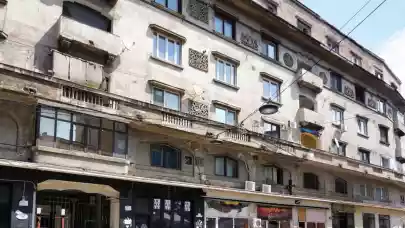
The latest Property Talks event, organised virtually by RICS Hungary, focused on renewable and alternative energy sources and their role in the built environment. Eight real estate experts shared their insight on this topic in the form of six presentations and one panel discussion.
Dr Paul Toyne (Sustainability Practice Leader at Grimshaw Architects)
The built environment is responsible for a significant portion (39%) of global greenhouse gas emissions, both directly (through the operation of buildings and infrastructure) and indirectly (through the manufacturing of building materials).
Global fossil CO2 emissions have increased by 61% since 1990 and the COVID-19 lockdowns of 2020 will only result in an estimated 8% reduction in annual CO2 emissions. Renewable energy is growing exponentially, but this growth has so far been too low to offset the growth in fossil energy consumption. Therefore, achieving our climate goals requires a drastic scaling of clean energy technologies.
Achieving net-zero emissions requires a radical transformation in the way we supply, transform and use energy. Reducing energy demand and driving energy efficiency in the built environment are two low-cost solutions that architects, design engineers and product suppliers can lead on.
Adam Targowski (Sustainovation Manager at Skanska Commercial Development Europe)
Skanska strives to reduce carbon emissions from its operations and provide customers with resilient, low-carbon solutions. The company’s net-zero carbon plan targets to cut greenhouse gas emissions by 50% by 2030 and to achieve net-zero greenhouse gas emissions by 2045.
Operational carbon footprint is mostly related to the energy that is used in buildings. Skanska has implemented a three-step plan to reduce its operational carbon footprint in its office buildings, The three steps are increasing energy efficiency (through the use of innovative products, design and education), energy production (through the installation of photovoltaic facades) and using green energy supply.
Tibor Tölgyes (Technical Supervisor at the Hungarian Chamber of Engineers)
According to the European Public Health Alliance (EPHA), air pollution costs the average European city resident €1,276 per year. The cost per capita in Budapest is even higher at €1,860 per year.
There are four steps companies can take to improve the energy performance in existing buildings: invest in technical installations (such as presence detectors, aerators on water taps or LED lights), verify and change the operation (align comfort parameters and operating hours with actual needs), influence behaviour and increase awareness (through campaigns and brainstorming sessions), revise and improve maintenance contracts.
Balázs Zuggó (CEO of Daikin)
Decarbonising the heating sector will be key to the making Europe a climate-neutral economy by 2050. Daikin embraces the EU Green Deal and believes that heat pumps will play an essential role in making Europe climate-neutral and in combining decarbonisation with sustainable economic growth.
Daikin’s HQ in Osaka, Japan, which was built in 2015 and achieved a LEED Platinum certification for New Construction, has achieved an 82% reduction in energy consumption compared to similar office buildings. This is due to the energy-efficient building structure (use of natural light and ventilation, use of thermal energy, improved performance of the building’s outer layer), the energy-efficient building equipment (ultra-high-efficiency air conditioning), the use of renewable energy (the photovoltaic system helped generate 160 MJ per sqm per year of solar energy) and efficient energy management.
Gábor Dicső (CEO of VPP Intelligent Energy)
Decarbonisation and electrification will drive the future energy supply. Utility thinking is old fashioned – onsite energy service is the new way. For example, refuelling fossil fuel-powered cars take unnecessary time and costs. Charging electric cars at home, at the office or at commercial and industrial buildings, on the other hand, will be cheaper and more comfortable.
Luigi Crema (Head of Applied Research on Energy Systems at Fondazione Bruno Kessler and Board Member at Hydrogen Europe Research)
Hydrogen is essential to decarbonise Europe. Hydrogen can enable large scale renewables integration and power generation, distribute energy across sectors and regions, act as a buffer to increase system resilience, in addition to helping decarbonise transportation, industrial energy use, building heat and power and it can also serve as renewable feedstock.
Although most of the tech solutions will only reach market readiness by 2030, the scale-up of the hydrogen sector in the EU presents a huge potential for impact in the economic sector. The European Hydrogen Strategy can help make hydrogen account for 24% of final energy demand, reduce annual CO2 emissions by 560 Mt, reduce polluting emissions by 15% and create 5.4 million jobs by 2050.



